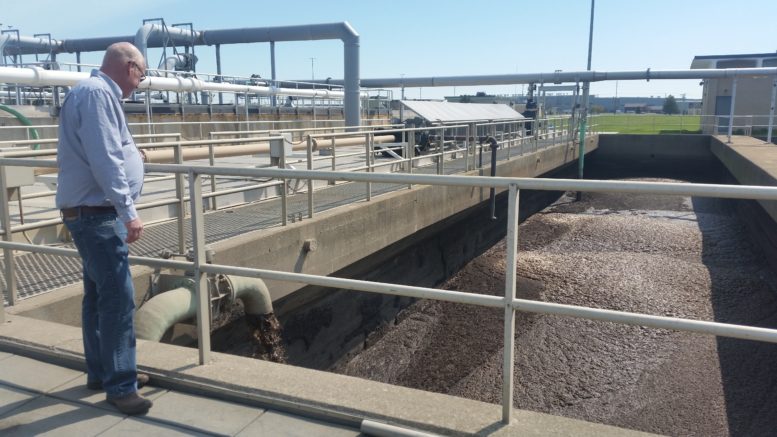By JAN LARSON McLAUGHLIN
BG Independent News
It’s not easy – or cheap – to make sewage smell like roses … or at least less like sewage. Bowling Green officials are considering spending about $478,000 to take away the foul odor that sometimes emanates from the city’s water pollution control facility on Dunbridge Road.
The plant is the source of many complaints, primarily from Bowling Green State University and from nearby businesses.
“It’s a sensitive issue for us,” Bowling Green Utilities Director Brian O’Connell said. “We’ve had numerous complaints from businesses in the area.”
The facility staff believes the two likely sources of the stench are the septage receiving station and the biofilter that removes the bacteria from the waste and turns it into a harmless solid. A misting odor neutralizer was added to the biofilter’s exhaust fan in 2016, but it has had limited success. The septage station has no odor control.
“The odors can be quite foul,” O’Connell said. “We’ve tried to get this problem licked in the past,” but the fixes always proved to be temporary.
So that sent the city’s utility staff on a field trip last year to a wastewater plant in Pennsylvania, according to O’Connell. The plant installed a carbon filter system to treat the exhaust air for odors. That change ended all odor complaints, including from the Holiday Inn located right next to the plant, O’Connell said.
The permit for the plant allows for “zero odor discharge from the perimeter,” said Doug Clark, superintendent of the Bowling Green plant.
“We want to be good neighbors,” O’Connell said.
So on Monday, O’Connell asked the Board of Public Utilities to approve the purchase of a larger exhaust fan, additional air piping and two carbon filter vessels for the biofilter. The two tanks would allow for one to serve as a backup. To combat odors from the septage station, two exhaust fans and carbon filter vessels were also proposed.
The cost to sweeten up the septage station is estimated at $190,512. The cost to fix the biofilter odors is estimated at $287,403 – for a total of $477,915. That cost is over the $300,000 budgeted last year for the project, O’Connell said. But the Water & Sewer Capital Improvement Fund can cover the additional costs, he told the board.
O’Connell plans to ask City Council to give all three readings of the resolution to purchase the equipment at the next council meeting. That way, construction could be complete by mid to late September. The work won’t be done by the time students move back into BGSU, but close, he said.
“BGSU will appreciate any assistance in this regard,” he said.
The Board of Public Utilities voted unanimously to support the purchases. “I’m in favor of being a good neighbor,” member Mike Frost said.
Frost mentioned that he has heard frequent comments from motorists along Interstate 75 about the odors from the plant. It does not present a pretty picture of the city.
“That’s an image improvement for us if that goes away,” he said of the strong odors.
As the city eyes costly improvements to spruce up the East Wooster corridor and the entrance to the city from I-75, some have questioned if the odors from the wastewater plant wafting over area will detract from the investment.
Clark is aware that strong sewer odors on some days are more detrimental than others, like the weekend of soccer tournaments due south of the plant. He conceded that the odors are particularly pungent on some days, especially when the wind is coming from the north, sending the smell toward businesses along Dunbridge Road.
The wastewater plant has made several attempts to sweeten the smells emitted. It uses an aerobic digestion process with bacteria that helps consume the waste. To lower the ammonia content, the wastewater is run through filters layered with large rocks, then smaller porous rocks, then root material. That process gets rid of some odors, but “quite frankly, not the most offensive ones,” Clark said.
But O’Connell and Clark are counting on the new equipment to work here just as it did at the plant they toured in Pennsylvania.
“It’s the belts and suspenders part of the equipment that takes care of the odors that get through the biofilter,” O’Connell said last year. “We’re hopeful it will benefit us the same way.”

